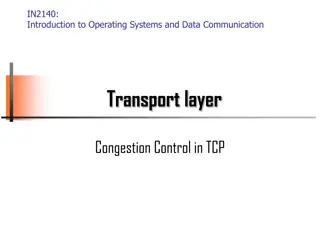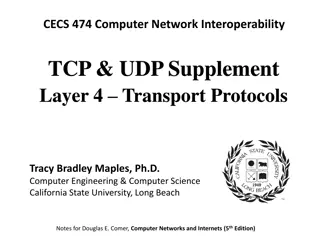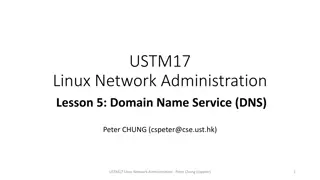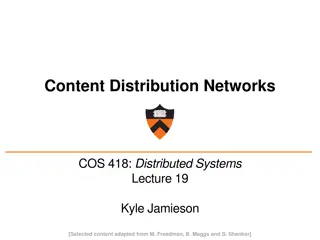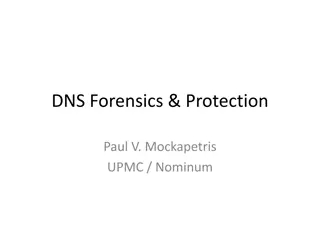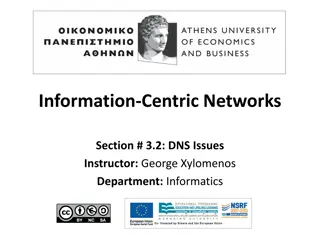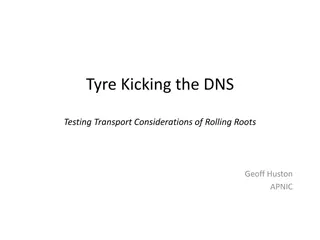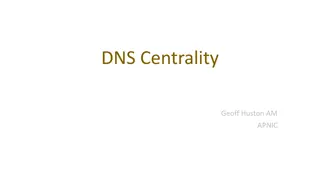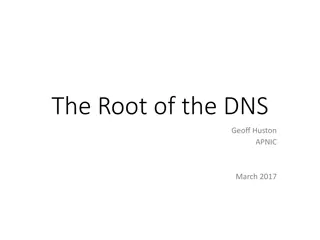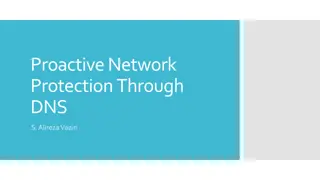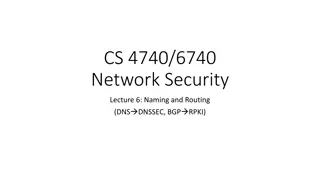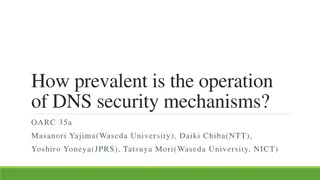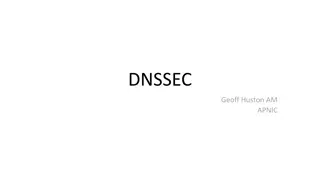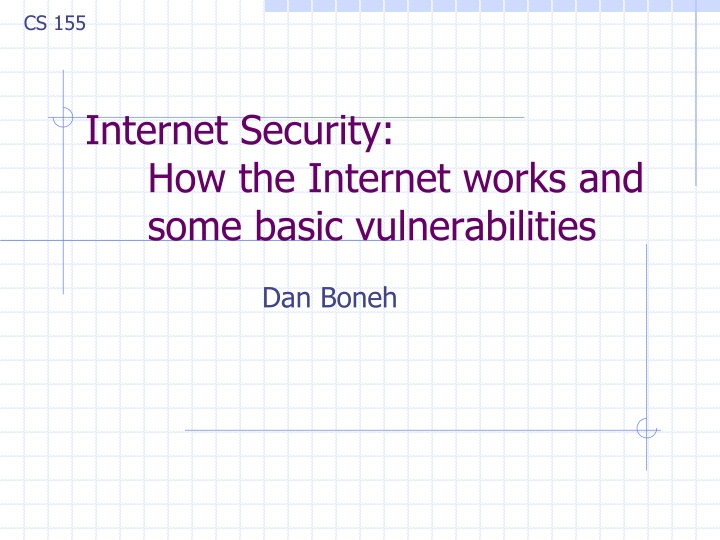
Understanding Internet Security and Vulnerabilities
Learn about how the Internet works, basic vulnerabilities, Internet infrastructure, TCP protocol stack, data formats, IP protocol functions, and more in this detailed guide on Internet security by Dan Boneh.
Download Presentation

Please find below an Image/Link to download the presentation.
The content on the website is provided AS IS for your information and personal use only. It may not be sold, licensed, or shared on other websites without obtaining consent from the author. If you encounter any issues during the download, it is possible that the publisher has removed the file from their server.
You are allowed to download the files provided on this website for personal or commercial use, subject to the condition that they are used lawfully. All files are the property of their respective owners.
The content on the website is provided AS IS for your information and personal use only. It may not be sold, licensed, or shared on other websites without obtaining consent from the author.
E N D
Presentation Transcript
CS 155 Internet Security: How the Internet works and some basic vulnerabilities Dan Boneh
Internet Infrastructure Backbone ISP ISP Local and interdomain routing TCP/IP for routing and messaging BGP for routing announcements Domain Name System Find IP address from symbolic name (www.cs.stanford.edu)
TCP Protocol Stack Application protocol Application Application TCP protocol Transport Transport IP protocol IP protocol IP Network Network Network Access Data Link Data Link Link Link
Data Formats TCP Header Application message - data message Application segment Transport (TCP, UDP) TCP data TCP data TCP data packet Network (IP) IP TCP data frame Link Layer ETH IP TCP data ETF IP Header Link (Ethernet) Header Link (Ethernet) Trailer
IP Internet Protocol Version Header Length Type of Service Total Length Identification Fragment Offset Connectionless Unreliable Best effort Flags Time to Live Protocol Header Checksum Notes: src and dest ports not parts of IP hdr Source Address of Originating Host Destination Address of Target Host Options Padding IP Data
IP Routing Meg Office gateway Packet Source Destination 121.42.33.12 132.14.11.51 Tom 121.42.33.12 132.14.11.1 ISP 132.14.11.51 121.42.33.1 Typical route uses several hops IP: no ordering or delivery guarantees
IP Protocol Functions (Summary) Routing IP host knows location of router (gateway) IP gateway must know route to other networks Fragmentation and reassembly If max-packet-size less than the user-data-size Error reporting ICMP packet to source if packet is dropped TTL field: decremented after every hop Packet dropped if TTL=0. Prevents infinite loops.
Problem: no src IP authentication Client is trusted to embed correct source IP Easy to override using raw sockets Libnet: a library for formatting raw packets with arbitrary IP headers Anyone who owns their machine can send packets with arbitrary source IP response will be sent back to forged source IP Implications: (solutions in DDoS lecture) Anonymous DoS attacks; Anonymous infection attacks (e.g. slammer worm)
TCP Transmission Control Protocol Connection-oriented, preserves order Sender Break data into packets Attach packet numbers Receiver Acknowledge receipt; lost packets are resent Reassemble packets in correct order Book Mail each page 1 Reassemble book 19 5 1 1
TCP Header (protocol=6) Source Port Dest port SEQ Number ACK Number P S R H U R G A C K P S S Y N F I N TCP Header Other stuff
Review: TCP Handshake C S SNC randC ANC 0 SYN: Listening SNS randS ANS SNC Store SNC , SNS SYN/ACK: Wait SN SNC+1 AN SNS ACK: Established Received packets with SN too far out of window are dropped
Basic Security Problems 1. Network packets pass by untrusted hosts Eavesdropping, packet sniffing Especially easy when attacker controls a machine close to victim (e.g. WiFi routers) 2. TCP state easily obtained by eavesdropping Enables spoofing and session hijacking 3. Denial of Service (DoS) vulnerabilities DDoS lecture
Why random initial sequence numbers? Suppose initial seq. numbers (SNC , SNS )are predictable: Attacker can create TCP session on behalf of forged source IP Breaks IP-based authentication (e.g. SPF, /etc/hosts ) Random seq. num. do not prevent attack, but make it harder TCP SYN srcIP=victim SYN/ACK dstIP=victim SN=server SNS Victim ACK Server srcIP=victim AN=predicted SNS attacker server thinks command is from victim IP addr command
Routing Security ARP, OSPF, BGP
Interdomain Routing (AS#32) Stanford.edu BGP earthlink.net (AS#4355) Autonomous System connected group of one or more Internet Protocol prefixes under a single routing policy (aka domain) OSPF
Routing Protocols ARP (addr resolution protocol): IP addr eth addr Security issues: (local network attacks) Node A can confuse gateway into sending it traffic for Node B By proxying traffic, node A can read/inject packets into B s session (e.g. WiFi networks) OSPF: used for routing within an AS BGP: routing between Autonomous Systems Security issues: unauthenticated route updates Anyone can cause entire Internet to send traffic for a victim IP to attacker s address Example: Youtube-Pakistan mishap (see DDoS lecture) Anyone can hijack route to victim (next slides)
BGP example [D. Wetherall] 3 2 7 3 2 6 5 4 1 2 7 2 6 5 3 2 6 5 5 2 7 6 5 8 2 7 2 6 5 2 7 7 6 2 7 7 2 6 5 5 6 7 5
Security Issues BGP path attestations are un-authenticated Anyone can inject advertisements for arbitrary routes Advertisement will propagate everywhere Used for DoS, spam, and eavesdropping (details in DDoS lecture) Often a result of human error Solutions: RPKI: AS obtains a certificate (ROA) from regional authority (RIR) and attaches ROA to path advertisement. Advertisements without a valid ROA are ignored. Defends against a malicious AS (but not a network attacker) SBGP: sign every hop of a path advertisement
Example path hijack (source: Renesys 2013) Feb 2013: Guadalajara Washington DC via Belarus route in effect for several hours Normally: Alestra (Mexico) PCCW (Texas) Qwest (DC) Reverse route (DC Guadalajara) is unaffected: Person browsing the Web in DC cannot tell by traceroute that HTTP responses are routed through Moscow
DNS Domain Name System Hierarchical Name Space root edu com uk net org ca stanford cmu mit ucb wisc cs ee www
DNS Root Name Servers Hierarchical service Root name servers for top-level domains Authoritative name servers for subdomains Local name resolvers contact authoritative servers when they do not know a name
DNS Lookup Example root & edu DNS server www.cs.stanford.edu stanford.edu DNS server Local DNS resolver Client cs.stanford.edu DNS server DNS record types (partial list): - NS: name server (points to other server) - A: address record (contains IP address) - MX: address in charge of handling email - TXT: generic text (e.g. used to distribute site public keys (DKIM) )
Caching DNS responses are cached Quick response for repeated translations Note: NS records for domains also cached DNS negative queries are cached Save time for nonexistent sites, e.g. misspelling Cached data periodically times out Lifetime (TTL) of data controlled by owner of data TTL passed with every record
DNS Packet Query ID: 16 bit random value Links response to query (from Steve Friedl)
Response to resolver Response contains IP addr of next NS server (called glue ) Response ignored if unrecognized QueryID
Authoritative response to resolver bailiwick checking: response is cached if it is within the same domain of query (i.e. a.com cannot set NS for b.com) final answer
Basic DNS Vulnerabilities Users/hosts trust the host-address mapping provided by DNS: Used as basis for many security policies: Browser same origin policy, URL address bar Obvious problems Interception of requests or compromise of DNS servers can result in incorrect or malicious responses e.g.: malicious access point in a Cafe Solution authenticated requests/responses Provided by DNSsec but few use DNSsec
DNS cache poisoning (a la Kaminsky08) Victim machine visits attacker s web site, downloads Javascript a.bank.com QID=x1 Query: a.bank.com local DNS resolver user browser .com response 256 responses: Random QID y1, y2, NS bank.com=ns.bank.com A ns.bank.com=attackerIP attacker wins if j: x1 = yj response is cached and attacker owns bank.com attacker
If at first you dont succeed Victim machine visits attacker s web site, downloads Javascript b.bank.com QID=x2 Query: local DNS resolver user browser .com b.bank.com response 256 responses: Random QID y1, y2, NS bank.com=ns.bank.com A ns.bank.com=attackerIP attacker wins if j: x2 = yj response is cached and attacker owns bank.com attacker success after 256 tries (few minutes)
Defenses Increase Query ID size. How? Randomize src port, additional 11 bits Now attack takes several hours Ask every DNS query twice: Attacker has to guess QueryID correctly twice (32 bits) but Apparently DNS system cannot handle the load
[DWF96, R01] DNS Rebinding Attack DNS-SEC cannot stop this attack <iframe src="http://www.evil.com"> www.evil.com? ns.evil.com DNS server 171.64.7.115 TTL = 0 192.168.0.100 Firewall www.evil.com web server corporate web server 171.64.7.115 192.168.0.100 Read permitted: it s the same origin
DNS Rebinding Defenses Browser mitigation: DNS Pinning Refuse to switch to a new IP Interacts poorly with proxies, VPN, dynamic DNS, Not consistently implemented in any browser Server-side defenses Check Host header for unrecognized domains Authenticate users with something other than IP Firewall defenses External names can t resolve to internal addresses Protects browsers inside the organization
Summary Core protocols not designed for security Eavesdropping, Packet injection, Route stealing, DNS poisoning Patched over time to prevent basic attacks (e.g. random TCP SN) More secure variants exist (next lecture) : IP IPsec DNS DNSsec BGP SBGP



